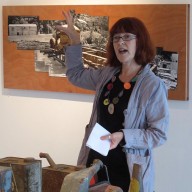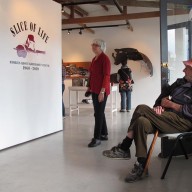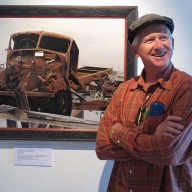A Slice of Life: Stories About the Truck
1960 – 2010
a community project
Exhibition dates [Extended] 4th May – 24th June 2013
CURATOR’S STATEMENT
The story of the exhibition began in 2011 when the Depot Art Space in Devonport began a series of events called ‘Cultural Mapping.’….mapping our cultural genealogy, and asked us if we would like to participate.The truck began its Hokianga career as a JG Richmond’s vehicle and has been part of this community in a historic, cultural and visual sense for nearly 60 years. It arrived in the Hokianga after WWII and departed in 2013.
The aim of this exhibition was to use the truck as a focus to uncover our social and cultural connections and to give them a visual focus. This truck has been photographed, documented, written about and published nationwide and the stories that go with this are what connects this community to each other and the rest of NZ. Stories are what make us who we are; they are the link between the past and the future.I would like to acknowledge everyone who participated in this project…those who told their stories, those who gave us art works, those who loaned us all the props. My thanks to my fellow Trustees for having faith in me and giving me their total support.
My thanks to FNDC Creative Communities for the funding they gave us to make this exhibition possible.
I would like to finish with a quote from the great NZ historian, Michael King.
“If we want to remain NZ’ers, feel like NZ’ers, and to present ourselves to the greater world as NZ’ers, then we must be able to listen to our own voices and trace our own footsteps”Curator: Marg Morrow
View report and photos at the Northern Advocate
Video courtesy of Yuko Guest
Rust in peace
by Tony Watkins
We are our stories. They define us and bring us into existence. They make us who we are. If we live life to the full, and tell our story well, comedy will meet tragedy and pathos will give way to triumph. People are endlessly interesting. Through crafting and mediating our stories we also discover who we are. As we reveal ourselves to others, inspiring or encouraging them, our story becomes woven into the great communal story. In the beginning was the word.
There is an old saying “The Atlantic belongs to the navigators”. Not the economists or the fishing fleet. Only love and knowledge make possession possible. Those who want to be one with the Atlantic need to read the stories of the navigators, not the statistics or even the scientific journals.
Gaylene Preston used to say “Some people travel the world and arrive home with nothing to say. Other people go down to the corner dairy and they come back with a story.” New Zealand belongs to those who watch the muddy debris, and detritus of life, swirling among the mangroves, brought in on the tide, and are filled with wonder. Life is in the detail. Good storytellers are observant. They belong.
We are our memories. We remember those who have gone before and we hope that those who follow will remember us too. A person who has lost their memory is but a shadow. They do not know who they are.
The greatest illness of our time is communal dementia. Towns which have forgotten and become just like all the other towns. People who have forgotten and become just like all the other people. When everyone plays someone else’s game reality is left behind. Children play computer games and adults play the stockmarket. The Kohukohu truck is forgotten.
In recent years our culture has moved from focusing on whanau to focusing on the individual. It has been a dangerous move. No cost is now too great for a personal heart operation, but the cost of saving a tree or a river is always too high. We have a future but the world does not.
Personal opinions have replaced communal memory. The news in the media is now no longer news. Instead we have opinions about the news. In a world where one individual is as good as another, one opinion is as good as another. In the confusion of this cacophony the person who shouts most loudly is heard, but then is quickly forgotten, because they never were of any consequence.
The focus of the New Zealand Historic Places Trust or the New Zealand Institute of Architects on individual buildings has resulted in built-environment communal dementia. Fragmentation has left decision makers also suffering from the disease. Even town planners create a game that reflects their profession’s communal dementia. Auckland’s desire to become “the most liveable city in the world” suggests that other cities can be forgotten.
The problem with elite sport, with its focus on the individual, is that it destroys sport. The best tennis matches are those where you lose track of the score because you are having so much fun. No one remembers who won because everyone was a winner. The problem with architectural awards with their focus on elite individualism is that they condemn ordinary people to lives of dull mediocrity. The best architecture never shouts at you. It catches a moonbeam and you feel you see life as you have never seen it before. The Kohukohu truck was so ordinary that it was extraordinary.
Maori would say that we begin looking to the future by looking at the past. We need political and social structures that recognise that the ordinary is extraordinary. We need a world where everyone matters. We need less competition and more cooperation. We need memories that will sustain us and tell us who we are. We need to write a chapter in a story that began long ago and pass that story on to others who will add their chapter while admiring the skill and delight of the chapter we have written.
Our artists, poets and playwrights understand all this. They give form to what we always knew, but could not bring into being. The photograph of a wharf pile lost in the morning mist captures only a moment, but it brings back memories of watching the dawn light strengthen and the fish jump. A poem takes us back to our half-forgotten childhood and we laugh. A playwright reaches into our soul to stir up emotions so deep that we break into a sweat.
Our stories and our memories are but a glimpse of a much greater reality. Life is rich, complex, and beyond our understanding. Every cloud is different, and every day the clouds are different. In our lifetimes we never see two clouds that are quite the same.
Flying above clouds some are filled with wonder at this complexity, while others pull down the blind. Most architecture is devoted to pulling down blinds, reducing the world to our own terms. The problem with our cities is not that we have lost touch with nature, but rather that we have lost touch with reality. We pay architects to create a world in our own image and likeness, forgetting that we do not even know who we are.
It is impossible for us to know what is important. We need to embrace, not exclude. We should never trust anyone who wants to clean up. Diversity and complexity are the foundations of sustainability. When we clean up we reduce potential, taking away possibilities. It is only when we look back that we can recognise what was important. We think we see clearly, but our assumptions and our predictions are always wrong.
Fundamentalism is the curse of our time. Bureaucrats reduce the wonder of a child or the ecstasy of a lover to something they can understand. Politicians and those seeking power make everyone the same, taking away their personal memories and their stories.
What we do need to clean up is the dross that stops us from seeing clearly. The mortgages that come between us and architecture. The greed that comes between us and nature. The resentment that comes between us and those who might be our friends. We need to clean up ourselves, not the world around us.
In the communal memory everyone is of significance. The whole is much greater than the sum of the parts. Unexpected juxtapositions and relationships add richness, new ways of seeing, and new possibilities. Rather than trying to discern what is significant we need to ease back into our armchair and conclude that everything is important. Rather than trying to pick the movers and shakers we need to see that everyone has value.
The Kohukohu truck has much to teach us.
If all this seems radical, it is. These are radical times. Unless we change our way of living we do not have a future. The world will go on but the human race will not be part of the story. Forget democracy. Think personal responsibility. Forget the adversarial thinking of our legal or political processes. Think cooperation. Forget success. Think love and compassion. Tomorrow’s city will not be the one where we got the design right, but rather the one most responsive to change.
Beware the person who has the plot of the story sorted out, and claims to know the meaning of life. They will miss the critical clue. The Kohukohu iconic truck.
Tony Watkins – April 2013




Pingback: Slice of Life | The Museum of the Vernacular